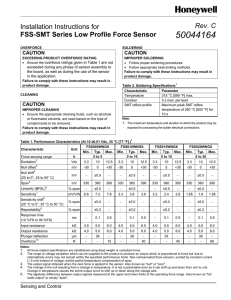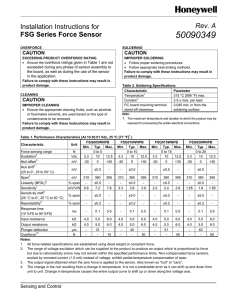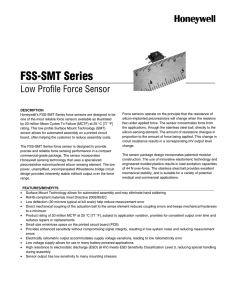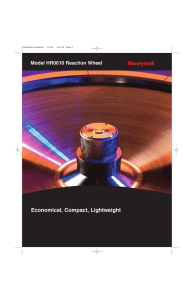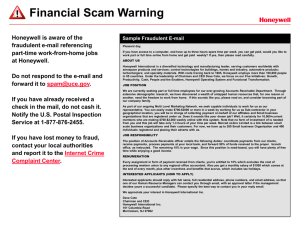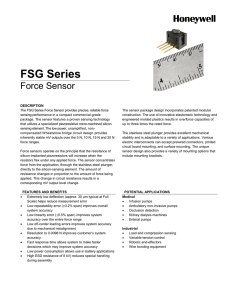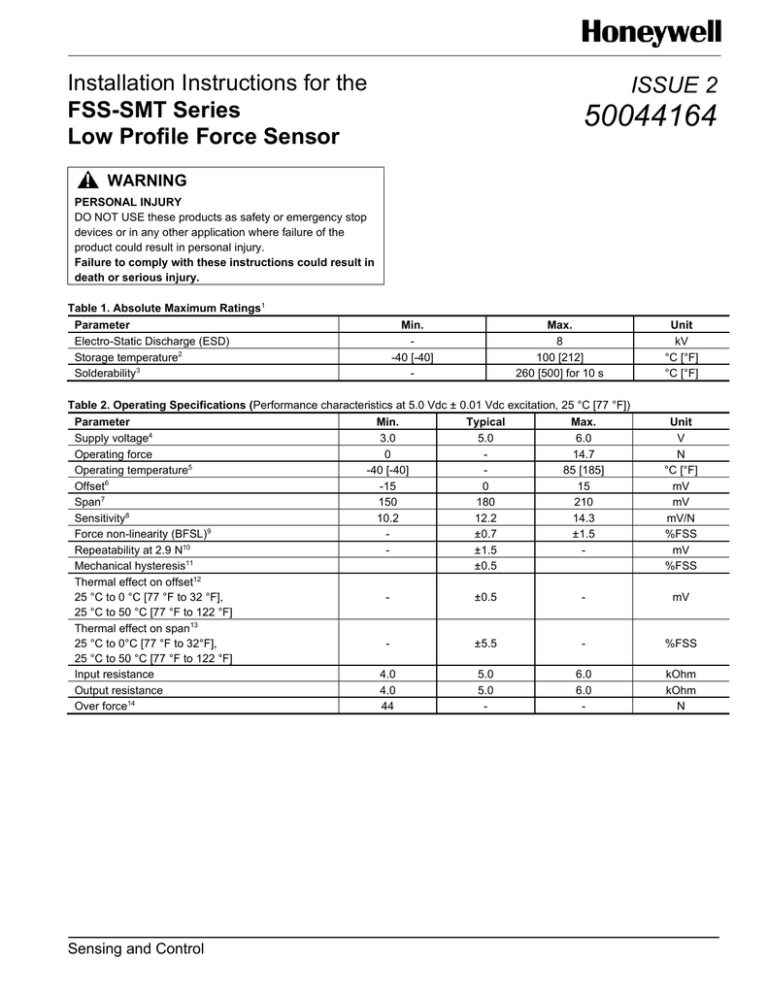
Installation Instructions for the
FSS-SMT Series
Low Profile Force Sensor
ISSUE 2
50044164
WARNING
PERSONAL INJURY
DO NOT USE these products as safety or emergency stop
devices or in any other application where failure of the
product could result in personal injury.
Failure to comply with these instructions could result in
death or serious injury.
Table 1. Absolute Maximum Ratings1
Parameter
Electro-Static Discharge (ESD)
Storage temperature2
Solderability3
Min.
-40 [-40]
-
Max.
8
100 [212]
260 [500] for 10 s
Table 2. Operating Specifications (Performance characteristics at 5.0 Vdc ± 0.01 Vdc excitation, 25 °C [77 °F])
Parameter
Min.
Typical
Max.
4
Supply voltage
3.0
5.0
6.0
Operating force
0
14.7
Operating temperature5
-40 [-40]
85 [185]
Offset6
-15
0
15
Span7
150
180
210
Sensitivity8
10.2
12.2
14.3
Force non-linearity (BFSL)9
±0.7
±1.5
Repeatability at 2.9 N10
±1.5
Mechanical hysteresis11
±0.5
Thermal effect on offset12
25 °C to 0 °C [77 °F to 32 °F],
±0.5
25 °C to 50 °C [77 °F to 122 °F]
Thermal effect on span13
25 °C to 0°C [77 °F to 32°F],
±5.5
25 °C to 50 °C [77 °F to 122 °F]
Input resistance
4.0
5.0
6.0
Output resistance
4.0
5.0
6.0
Over force14
44
-
Sensing and Control
Unit
kV
°C [°F]
°C [°F]
Unit
V
N
°C [°F]
mV
mV
mV/N
%FSS
mV
%FSS
mV
%FSS
kOhm
kOhm
N
FSS-SMT Series
Issue 2
50044164
Table 3. Environmental Specifications
Parameter
Characteristic
Shock
Qualification tested to 150 G
Vibration
Qualification tested to 0 to 2 kHz, 20 G sine
Mean Cycles To Failure (MCTF)15
20 million at 25 °C [77 °F]
Notes:
1. Absolute maximum ratings are the extreme limits that the device can withstand without damage to the device.
2. The temperature range over which the product may safely be exposed without excitation or force applied. Under these
conditions the product will remain in specification after excursion to any temperatures in this range. Exposure to temperatures
beyond this range may cause permanent damage to the product.
3. The maximum temperature and time for which the product can be exposed to for processing of solder electrical connections.
4. The range of voltage excitation which can be supplied to the product to produce an output which is proportional to Force but
due to Ratiometricity errors may not remain within the specified performance limits.
5. The temperature range over which the product will produce an output proportional to force but may not remain within the
specified performance limits.
6. The output signal obtained when the zero force is applied to the sensor. Also known as "null" or "zero".
7. The algebraic difference between the output signal measured at the upper and lower limits of the Operating Force Range.
Also known as "full scale output" or simply "span".
8. The ratio of output signal change to the corresponding input force change. Sensitivity is determined by computing the ratio of
Span to the specified Operating Force Range.
9. Force Non-Linearity (Best Fit Straight Line): The maximum deviation of product output from a straight line fitted to output
measured over the operating force range. The straight line through a set of points which minimizes the sum of the square of
the deviations of each of the points from the straight line.
10. The maximum difference between output readings when the same force is applied consecutively, under the same operating
conditions, with force approaching from the same direction within the operating force range.
11. The maximum difference between output readings when the same force is applied consecutively, under the same operating
conditions, with force approaching from opposite directions within the operating force range.
12. The maximum deviation in Offset due to changes in temperature over the Operating Temperature Range, relative to Offset
measured at 25 °C.
13. The maximum deviation in Full Scale Span due to changes in temperature over the Operating Temperature Range, relative to
Full Scale Span measured at 25 °C.
14. The maximum force which may safely be applied to the product for it to remain in specification once force is returned to the
Operating Force Range. Exposure to higher forces may cause permanent damage to the product. Unless otherwise specified
this applies to all temperature within the Operating Temperature Range.
15. MCTF is a basic measure of reliability for a non-repairable device. It is the mean number of cycles to maximum operating force
over which a sensor can be expected to operate until failure. The mean value is determined statistically from a probability
distribution for failures based upon test data. MCTF may vary depending on the specific application in which a sensor is
utilized.
FSS-SMT Series
Figure 1. Sensor Pinout
Issue 2
50044164
Figure 2. Excitation Schematics – Excitation 5 Vdc Typ.,
6 Vdc max.
FSS Series Circuit
1. Circled numbers refer to sensor terminals (pins).
Pin 1 = Supply Vs (+)
Pin 2 = Output Vo (+)
Pin 3 = Ground Vg (-)
Pin 4 = Output Vo (-)
2. The force sensor may be powered by voltage or current. Maximum supply voltage is not to exceed 6 V. Maximum supply current
is not to exceed 1.2 mA. Power is applied across Pin 1 and Pin 3.
3. The sensor output should be measured as a differential voltage across Pin 2 and Pin 4 (Vo=Vo(+)-Vo(-)). The output is
ratiometric to the supply voltage. Shifts in supply voltage will cause shifts in output. Neither Pin 2 nor Pin 4 should be tied to
ground or voltage supply.
Figure 3. Mounting Dimensions (for reference only) in mm
FSS-SMT Series
Issue 2
50044164
Figure 4. Suggested Land Pattern in mm
WARRANTY/REMEDY
Honeywell warrants goods of its manufacture as being free of
defective materials and faulty workmanship. Honeywell’s
standard product warranty applies unless agreed to otherwise
by Honeywell in writing; please refer to your order
acknowledgement or consult your local sales office for specific
warranty details. If warranted goods are returned to Honeywell
during the period of coverage, Honeywell will repair or replace,
at its option, without charge those items it finds defective. The
foregoing is buyer’s sole remedy and is in lieu of all other
warranties, expressed or implied, including those of
merchantability and fitness for a particular purpose. In no
event shall Honeywell be liable for consequential, special,
or indirect damages.
SALES AND SERVICE
Honeywell serves its customers through a worldwide network
of sales offices, representatives and distributors. For
application assistance, current specifications, pricing or name
of the nearest Authorized Distributor, contact your local sales
office or:
While we provide application assistance personally, through
our literature and the Honeywell web site, it is up to the
customer to determine the suitability of the product in the
application.
Europe
+44 (0) 1698 481481
+44 (0) 1698 481676 Fax
Latin America
+1-305-805-8188
+1-305-883-8257 Fax
USA/Canada
+1-800-537-6945
+1-815-235-6847
+1-815-235-6545 Fax
Specifications may change without notice. The information we
supply is believed to be accurate and reliable as of this printing.
However, we assume no responsibility for its use.
E-mail: info.sc@honeywell.com
Internet: www.honeywell.com/sensing
Phone and Fax:
Asia Pacific
+65 6355-2828
+65 6445-3033 Fax
50044164-2-EN IL50 GLO Printed in USA
July 2009
Copyright © 2009 Honeywell International Inc. All rights reserved.

